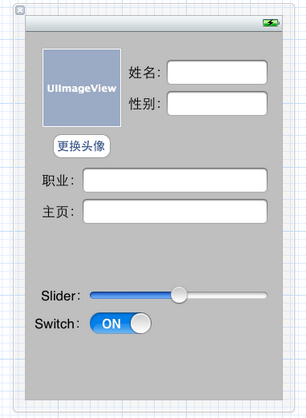iOS开发22:通过归档永久存储数据
来源:互联网 发布:c语言数组转字符串 编辑:程序博客网 时间:2024/04/29 11:58
转载自双子座博客:博客原文链接 http://my.oschina.net/plumsoft/blog/57180
之前一篇文章《iOS开发20:使用Settings Bundle为程序添加设置项》中简单介绍了怎样在Settings程序中设置自己的程序,并实现保存,使得下次运行自己的程序时显示的还是上次的设置项。而上一篇文章介绍SandBox时,我们看到其实使用Settings程序设置后,数据是保存在一个plist文件的。
想要永久保存数据,我们当然可以使用plist文件,当退出程序时,我们执行将数据写入plist文件的操作,使用writeToFile:atomically:方法。
具有这个方法的类有:
NSArrayNSMutableArrayNSDictionaryNSMutableDictionaryNSDataNSMutableDataNSStringNSMutableStringNSNumberNSDate
例如,我们的数据存储在NSArray的一个对象array中,保存数据时执行:
[array writeToFile:filePath atomically:YES];
其中filePath是放在SandBox中的一个plist文件的完整路径。
不过,使用plist文件还是有局限性的,例如,我们不好将一个图片存储在plist中。
这次的小例子中,我们将会通过归档实现数据的保存。当程序运行时,先检查归档文件是否存在,如果存在的话就从归档文件中读取数据显示在界面上;如果归档文件不存在,就使用默认设置。当程序关闭时,会将数据存储在归档文件中,这样下次运行程序时就会显示上次的设置了。
1、运行Xcode 4.3,新建一个Single View Application,名称为:Archiving Test:

然后将准备好的两张图片添加到工程中。
2、先进行界面设计:
单击ViewController.xib,向其中添加控件:

然后向ViewController.h中为控件建立Outlet映射和Action映射,具体是为所有的TextField、ImageView、UISlider控件和UISwitch控件建立Outlet映射,为Button建立Action映射:

3、新建一个类,用于存储我们的数据:
在菜单栏依次选择File — New — File…,在打开的窗口选择Objective-C Class:

单击Next,输入类名:ArchivingData,选择super class为NSObject:

单击Next,选好位置和分组,点击创建,完成类的建立。
4、打开ArchivingData.h,向其中添加属性,以及协议:
#import <Foundation/Foundation.h>@interface ArchivingData : NSObject <NSCoding, NSCopying>@property (copy, nonatomic) UIImage *image;@property (copy, nonatomic) NSString *name;@property (copy, nonatomic) NSString *gender;@property (copy, nonatomic) NSString *vocation;@property (copy, nonatomic) NSString *page;@property float theSlider;@property BOOL isSwitchOn;@end
5、打开ArchivingData.m,向其中添加代码:
5.1 在@implementation之前添加代码:
#define kImageKey @"ImageKey"#define kNameKey @"NameKey"#define kGenderKey @"GenderKey"#define kVocationKey @"VocationKey"#define kPageKey @"PageKey"#define kTheSliderKey @"TheSliderKey"#define kIsSwitchOn @"IsSwitchOnKey"
5.2 在@implementation之后添加代码:
@synthesize image;@synthesize name;@synthesize gender;@synthesize vocation;@synthesize page;@synthesize theSlider;@synthesize isSwitchOn;
5.3 在@end之前添加代码:
#pragma mark NSCoding- (void)encodeWithCoder:(NSCoder *)aCoder { [aCoder encodeObject:image forKey:kImageKey]; [aCoder encodeObject:name forKey:kNameKey]; [aCoder encodeObject:gender forKey:kGenderKey]; [aCoder encodeObject:vocation forKey:kVocationKey]; [aCoder encodeObject:page forKey:kPageKey]; [aCoder encodeFloat:theSlider forKey:kTheSliderKey]; [aCoder encodeBool:isSwitchOn forKey:kIsSwitchOn]; }- (id)initWithCoder:(NSCoder *)aDecoder { if (self = [super init]) { image = [aDecoder decodeObjectForKey:kImageKey]; name = [aDecoder decodeObjectForKey:kNameKey]; gender = [aDecoder decodeObjectForKey:kGenderKey]; vocation = [aDecoder decodeObjectForKey:kVocationKey]; page = [aDecoder decodeObjectForKey:kPageKey]; theSlider = [aDecoder decodeFloatForKey:kTheSliderKey]; isSwitchOn = [aDecoder decodeBoolForKey:kIsSwitchOn]; } return self;}5.4 在@end之前添加代码:
#pragma mark NSCoping- (id)copyWithZone:(NSZone *)zone { ArchivingData *copy = [[[self class] allocWithZone:zone] init]; copy.image = self.image; copy.name = [self.name copyWithZone:zone]; copy.gender = [self.gender copyWithZone:zone]; copy.vocation = [self.vocation copyWithZone:zone]; copy.page = [self.page copyWithZone:zone]; copy.theSlider = self.theSlider; copy.isSwitchOn = self.isSwitchOn; return copy;}在ArchivingData类中,我们添加了几个属性,这些属性与上面创建的控件是一一对应的。之后实现了几个协议方法,这些方法分别用于编码、解码和复制。
6、打开ViewController.h,向其中添加属性和方法:
@property (copy, nonatomic) NSString *archivingFilePath;- (void)applicationWillResignActive:(NSNotification *)notification;
7、打开ViewController.m,添加代码:
7.1 在@implementation之后添加代码:
@synthesize archivingFilePath;
7.2 在#import之后添加代码:
#import "ArchivingData.h"#define kArchivingFileKey @"archivingFile"#define kArchivingDataKey @"ArchivingDataKey"
7.3 在viewDidLoad方法中添加代码:
- (void)viewDidLoad{ [super viewDidLoad]; // Do any additional setup after loading the view, typically from a nib. NSArray *paths = NSSearchPathForDirectoriesInDomains(NSDocumentDirectory, NSUserDomainMask, YES); NSString *documentsDirectory = [paths objectAtIndex:0]; self.archivingFilePath = [documentsDirectory stringByAppendingPathComponent:kArchivingFileKey]; NSFileManager *fileManager = [NSFileManager defaultManager]; if ([fileManager fileExistsAtPath:self.archivingFilePath]) { //如果归档文件存在,则读取其中内容,显示在界面上 NSData *data = [[NSMutableData alloc] initWithContentsOfFile:self.archivingFilePath]; NSKeyedUnarchiver *unarchiver = [[NSKeyedUnarchiver alloc] initForReadingWithData:data]; ArchivingData *archivingData = [unarchiver decodeObjectForKey:kArchivingDataKey]; [unarchiver finishDecoding]; theImageView.image = archivingData.image; nameTextField.text = archivingData.name; genderTextField.text = archivingData.gender; vocationTextField.text = archivingData.vocation; pageTextField.text = archivingData.page; theSlider.value = archivingData.theSlider; theSwitch.on = archivingData.isSwitchOn; } else { //如果归档文件不存在,则设置imageView为boy.png theImageView.image = [UIImage imageNamed:@"boy.png"]; } //当程序进入后台时,将当前设置项写入归档文件 UIApplication *app = [UIApplication sharedApplication]; [[NSNotificationCenter defaultCenter] addObserver:self selector:@selector(applicationWillResignActive:) name:UIApplicationWillResignActiveNotification object:app];}7.4 找到switchImage方法,添加代码:
- (IBAction)switchImage:(id)sender { UIImage *image1 = [UIImage imageNamed:@"boy.png"]; UIImage *image2 = theImageView.image; if (![image1 isEqual:image2]) { theImageView.image = image1; } else { theImageView.image = [UIImage imageNamed:@"gemini.png"]; }}7.5 在@end之前添加代码:
//程序进入后台时,保存设置- (void)applicationWillResignActive:(NSNotification *)notification { ArchivingData *archivingData = [[ArchivingData alloc] init]; archivingData.image = self.theImageView.image; archivingData.name = self.nameTextField.text; archivingData.gender = self.genderTextField.text; archivingData.vocation = self.vocationTextField.text; archivingData.page = self.pageTextField.text; archivingData.theSlider = theSlider.value; archivingData.isSwitchOn = theSwitch.on; NSMutableData *data = [[NSMutableData alloc] init]; NSKeyedArchiver *archiver = [[NSKeyedArchiver alloc] initForWritingWithMutableData:data]; [archiver encodeObject:archivingData forKey:kArchivingDataKey]; [archiver finishEncoding]; [data writeToFile:self.archivingFilePath atomically:YES];}8、最后,为了使得键盘可以关闭,我们还要添加关闭键盘的操作,参考《iOS开发4:关闭键盘》中的第2步。
9、运行程序
刚运行程序如下左图:


我们添加一些数据,更换头像,再调整Silder和Switch,如上图右。
之后,按模拟器上的Home建,使得程序在后台运行。
此时,查看程序的SandBox,可以看到程序的Documents目录下出现了文件archivingFile:

之后使用Xcode结束运行,再运行程序。程序第二次运行时,显示如上图左,这说明我们实现了数据的永久存储。
- iOS开发22:通过归档永久存储数据
- iOS开发22:通过归档永久存储数据
- 通过归档永久存储数据
- 通过归档永久存储数据
- 通过归档永久存储数据
- 通过归档永久存储数据
- 通过归档永久存储数据
- iOS归档存储数据
- iOS开发归档存储
- iOS开发过程中一些数据的存储归档
- iOS数据存储之---归档
- ios数据存储之归档
- ios 沙盒 NSCoding 归档 数据存储
- iOS 数据的本地存储-对象归档
- ios应用数据存储方式(归档)
- 归档—ios应用数据存储方式
- ios应用数据存储方式(归档)
- ios应用数据存储方式(归档)
- JSONObject.fromObject(map)(JSON与JAVA数据的转换)
- 练习_3_数字和字符
- Tonec Inc Internet Download Manager v6 12 23 Incl Keygen and Patch-BRD
- fedora如何下载软件
- ORA-39149: 无法将授权用户链接到非授权用户
- iOS开发22:通过归档永久存储数据
- MetaProducts Portable Offline Browser v6 4 3860 SR1 Multilingual Incl Keygen and Patch-BRD
- BSS段
- whu 1124 最大流和sgu 326 思路一样
- javascript 比较数组中值大小 jquery 多值的大小
- VC++深入详解(10):文件的读写
- c# 获取目录
- asp.net数据集导出excel表
- 介绍LuaPlus: 好用的Lua For C++扩展(修订)


